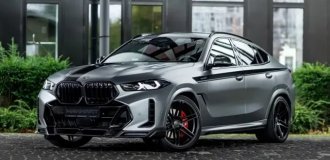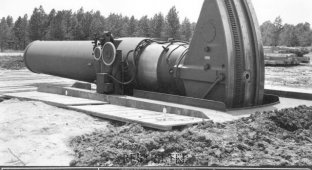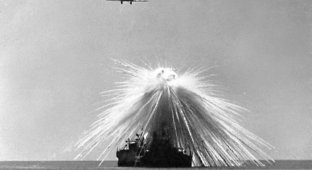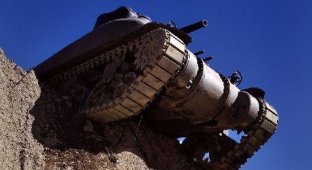Sturmtiger (German: Sturmtiger), full official name - 38 cm RW61 auf Sturmmrser Tiger, also a common name - Sturmpanzer VI (German: Sturmpanzer VI) is a German self-propelled artillery unit (SPG) during the Second World War, a class of assault guns, heavy by weight. Created in 1943 on the chassis of the Tiger heavy tank and intended for the destruction of enemy fortifications and battles in urban environments.

During World War II, Germany produced various specialized types of armored vehicles, including the Sturmpanzer - assault tanks. They were used as heavy infantry support vehicles in street fighting in large cities. They were used mainly against buildings and in operations against heavily fortified enemy defenses. The first assault tank was the Sturminfanteriegeschutz 33, developed on the chassis of the Panzer III medium tank. He was armed with 150 mm. heavy infantry howitzer sIG.

After it, the Sturmpanzer IV Brummbar was developed, which was based on the chassis of the Panzer IV medium tank and was armed with 150 mm. assault howitzer StuH (Sturmhaubitze). 306 of these vehicles, produced between 1943 and 1945, took part in combat operations on all fronts. The heaviest and most powerful of the assault tanks was the Sturmtiger, which entered service with the German army at the end of 1944. This was the result of completing work on a similar project - Sturmpanzer Bar.

In the fall of 1942, after heavy fighting at Stalingrad, the concept of a heavy self-propelled infantry support assault gun, designed specifically for street fighting, was developed. At the time, the only tank specifically designed for this role was the Sturminfanteriegeschutz 33, while the Sturmpanzer IV Brummbar was still under development. At first it was planned to arm the Sturmtiger 210mm. howitzer, but it was not available at that moment. On August 5, 1943, it was decided to install a modified Tiger 380mm rocket launcher/mortar in a new superstructure.

The new vehicle was designated 38cm RW61 auf Sturm(panzer)morser Tiger, but this tank is also known as Sturmtiger, Sturmpanzer VI and Tiger-Morser. The most commonly used designation was Sturmtiger. The new vehicle was similar in layout and role assigned to it to the Brummbar, but had a heavier chassis and armament. Alkett received an order to produce the first prototype by October 1943. On October 20, 1943, the Sturmtiger prototype was presented to Adolf Hitler at the Arys training ground in East Prussia. This prototype was based on the Tiger intermediate version (road wheels with rubber tires) and a superstructure made of iron armor plates (mild steel).

The prototype was intensively tested and was put into production in April 1944. For production, battle-damaged late Tiger models (road wheels with steel tires) were used instead of new ones. From August to December 1944, Alkett assembled only 18 Sturmtiger (chassis numbers 250043 to 251174). 10 vehicles were produced in September and another 8 in December 1944. It was originally planned to produce 10 of these machines per month, but this production rate was never achieved.

In 1943-1945. 18 Sturmtigers were converted from line tanks, including the prototype. They were used in battle almost until the very end of the war, to a limited extent, but due to their extremely small numbers, lack of suitable targets, unreliability and supply problems, the Sturmtigers did not have any noticeable impact on the course of hostilities.

The main armament of the Sturmtiger was a 380-mm ship-borne rocket launcher Raketenwerfer 61 (military designation 38 cm RW61 or StuM RM 61 L/5) with a barrel length of 5.4 calibers. The bomb launcher was installed in the front panel of the cabin in a ball mount.

The Sturmtiger was armed with 380mm. a breech-loading short-barreled mortar Raketenwerfer 61 L/5.4, which fired huge rocket shells of great destructive power at close range (4600-6000m). This weapon was developed by Rheinmetall-Borsig based on a naval depth charge launcher. For local defense, 7.92mm was installed on the front armor plate. MG34 machine gun. The Sturmtiger was capable of destroying any building or other target with a single shot.

True, its ammunition was only 14 rockets (weighing 345-351 kg each). 12-13 shells were stored on special stands inside the superstructure and 1 in the mortar barrel. The vehicle was equipped with a hand crane that helped to load the mortar. This operation required the efforts of the entire crew. On August 12, 1944, the Sturmtiger prototype was sent to the Polish city of Pruzshkow and then to Warsaw to help suppress the rebellious Polish People's Army. One of the unexploded Sturmtiger shells can be seen today on display at the Wojska Polskiego Museum in Warsaw.



Some of them took part in the offensive in the Ardennes, but most took part in the defense along the banks of the Rhine. The Sturmtiger proved to be an excellent defensive weapon, but they were all later destroyed by heavy artillery fire or air attacks. There is a report that a single shot from a Sturmtiger completely destroyed three American M4 Sherman tanks. Today, a fully restored and functioning Sturmtiger can be seen at the Auto & Technik Museum in Sinsheim, Germany.


In total, as of March 1, 1945, there were 13 Sturmtigers in units, three vehicles were in warehouses, another vehicle was lost, and this number does not include the prototype, which was decommissioned back in October 1944. A very rare model indeed!


In World War II, besides Germany, only the USSR possessed specialized heavily armored assault guns. An approximate analogue of the Sturmtiger can be the heavy self-propelled guns SU-152 and ISU-152, however, the latter were more universal and were not created specifically for combat in urban environments.

From a purely engineering point of view, the car is outstanding. But its expediency is characterized by the phrase of General Halder about another German combat vehicle of that time *: “A real work of art, but useless.” 813 mm siege gun "Dora"

























